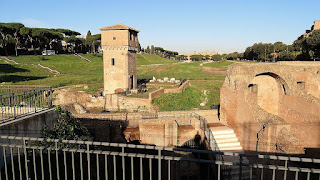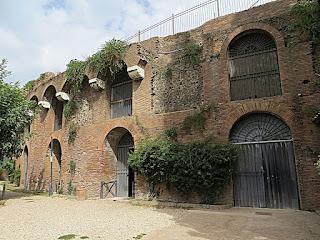City devastated by nine-day blaze
 |
| An 18th century depiction of the Great Fire by the French artist Hubert Robert |
Accounts vary as to whether the blaze began on July 19 or on the evening of July 18. What seems not to be in doubt is that the fire spread uncontrollably for six days, seemed to burn itself out, then reignited and continued for another three days.
Of Rome’s 14 districts at the time, only four were unaffected. In three, nothing remained but ashes and the other seven fared only marginally better, with just a few scorched ruins still standing.
Among the more important buildings in the city, the Temple of Jupiter Stator, the House of the Vestals, and the emperor Nero's palace, the Domus Transitoria were damaged or destroyed, along with the part of the Forum where senators lived and worked.
According to the historian Publius Cornelius Tacitus, who published an account of the fire in his Annals, which covered the period from Tiberius to Nero, the blaze probably began in shops around Rome's chariot stadium, Circus Maximus.
 |
| The fire is thought to have started close to Circus Maximus (above), the Roman chariot stadium |
Fires were commonplace in the city but this was exceptional. Although Rome’s aqueducts brought water into the city, many were in a state of disrepair and none was fitted with fire-fighting equipment. The only weapons Romans had at their disposal were buckets and blankets, which proved hopelessly inadequate. The only hope of containing a blaze was to demolish all the buildings around it and deny it the opportunity to spread.
Although such fires were not rare, it was not long before rumours began to circulate that this was not a random event caused by freakish temperatures but an inside job, specifically a job organised by Nero himself.
In his account, Tacitus noted that in some areas attempts to fight the flames were prevented by ‘menacing gangs’ and that some of these men claimed they were ‘acting under orders’.
 |
| Nero during the fire, imagined by artist Gustave Surand |
Although the emperor himself was thought to be staying in Antium - now Anzio - a coastal resort south of Rome, when the fire broke out, many stories suggested that Nero sent men to set fires all over the city. The stories in many cases included the detail that Nero watched the blaze unfold from either the Palatine or Esquiline Hill, singing and playing his lyre as he did so.
In some minds, the speed at which he unveiled plans to rebuild neighbourhoods in the Greek style and to launch construction of his new palace, the ostentatious Domus Aurea (Golden House), were more evidence that he was behind the fire.
Nonetheless, the city that emerged in the place of the old Rome, with an urban plan that can still be traced in the city’s layout today, showed Nero’s far-sightedness. He introduced much more strict building regulations and much greater use was made of marble and stone in construction. The new city also had wide streets and pedestrian areas which made it more difficult for fires to spread, plus an abundant water supply for firefighters to use to help control future incidents.
Nero is also credited by historians with determining that debris from the fire was used as fill for the nearby malaria-infested marshes, which had plagued Romans for decades. There was, though, a price that had to be paid for all the work in increased taxation, plus the inflationary effect of his decision to devalue the Roman currency.
According to Tacitus, in order to end the rumours that the fire was started on his orders, Nero blamed the blaze on the Christians, who at the time had only a small presence in Rome, leading him to launch the first in a series of persecutions of the religious group that continued for 250 years.
Nero was deposed only four years after the Great Fire when the Praetorian Guard rose against him. He died in what would be described today as an assisted suicide, ordering an aide to plunge a knife into his chest before soldiers from the Praetorian Guard arrived to arrest him.
Travel tip:
A section of the rediscovered Domus Aurea, the
complex Nero built after the Great Fire of 64 AD
After Nero’s death, the Domus Aurea - a complex of palaces and pavilions in a landscaped park with an artificial lake and a gigantic bronze statue of himself, was stripped of its treasures, with its marble, jewels and ivory removed. The complex was filled with earth and new buildings rose in its place. The Baths of Titus, the Flavian Amphitheatre, the Colossus Neronis, the Baths of Trajan and the Temple of Venus and Rome were all built on the site, obliterating all visible traces of the Golden House. It was rediscovered during the Renaissance, when a young man fell down a hole on the site and found himself in the cavernous, subterranean rooms of Nero’s palace. It was discovered that beautiful, intricate frescoes remained, preserved from dampness by the buildings above. Since then, various restoration projects have taken place and are ongoing, with guided tours of parts of the complex now available.
Travel tip:.jpg)
A view of the modern port of Anzio, site of the
former Roman coastal city of Antium
The site of the Roman resort of Antium is occupied in part by Anzio, a fishing port about 57km (35 miles) south of Rome on the coast of Lazio. As well as being the birthplace, according to some historians, of both Nero and Caligula, Antium was popular with Romans as a place to build a summer residence. The remains of numerous villas exist along the coastline, including Nero’s own Domus Neroniana, and many Roman works of art have been discovered in the area. Anzio’s other significance in history is that it was the location chosen for a massive Allied landing in January 1944, as a result of which the town was badly damaged in fighting between the invasion force and German troops determined to prevent their advance on Rome. Much of it therefore had to be rebuilt.
Also on this day:
1249: The death of Venetian doge Jacopo Tiepolo
1374: The death of the poet Francesco Petrarca, generally known as Petrarch
1631: The death of philosopher Cesare Cremonini


%20(1).jpg)
.jpg)




%20(1).jpg)


